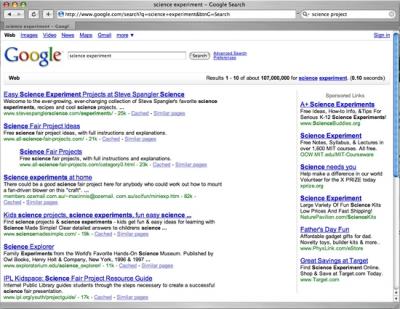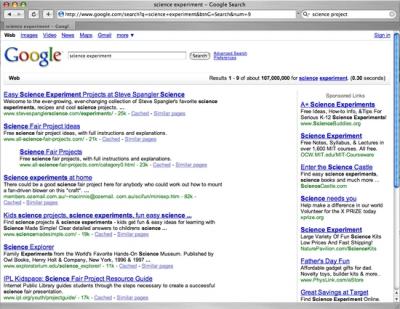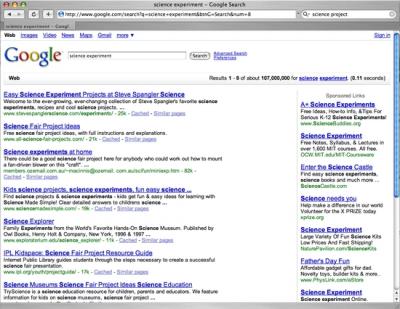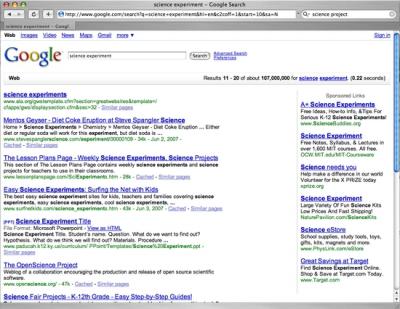Deconstructing Grouped Google Results
My favorite session at SMX Advanced last month was “Give It Up,” the session where panelists shared little-known secrets. I’m a little biased, since that was the panel I spoke on. But still, as the last session of the two days, it really ended the conference with a bang. For those of you who didn’t attend, there was a 30 day moratorium on blogging/writing about the session. Today marks the end of that embargo period, so without further ado, here’s the secret:
You probably know that Google will group two results together when they are both from the same site,indenting the second of the two results indented beneath the first one. Let’s say, for sake of argument, that a competitor of yours is ranked #1 and #2. But did you know that the listing ranked #2 is most likely not actually #2, rather something between #3 and #10? The second, indented result could very well have as its “true” position #10. If that’s the case, the second listing is much more susceptible to getting bumped on to page two of the Google SERPs. And if that happens, your competitor goes from having two listings on the first page to having only one. Nice!
And do you know how to ascertain the true position of an indented (grouped) result? Simply append &num=9 to the URL of the Google SERP, to show results 1-9 instead of 1-10, and see if the indented listing drops off. If it doesn’t, revise &num=9 to &num=8. Continue iterating downward until the indented listing falls away.
Let’s look at an example…
A search on Google for “science experiment” returns one of our (Netconcepts’) clients at #1, as evidenced in the screenshot above. But notice the competitor at positions #2 and #3. Let’s say we wanted to take out that competitor’s second listing (i.e. position #3). First we need to determine what the true ranking is of that indented listing. We do this by appending &num=9 to the Google URL, like so:
Hmm. Both listings are still there. Time to try &num=8 instead, like so:
Bingo! The indented search result is gone,relegated to page 2. That must mean that the true position is 9, not 3.
Armed with this new information, I then review who’s positioned near the top of page 2 and decide who I’m going to help onto page 1 to bump out the competitor. In this case, it’s a no-brainer who to give a boost to,our client is also at position 12 (albeit with a different page):
There’s an extra bonus here’this #12 listing, if it makes it onto page 1, will end up getting grouped at #2, right under our client’s #1 ranking. Including the phrase “science experiment” into this page’s title tag is an obvious first step towards bumping this listing onto page 1.
Because the competitor’s second listing has 9 as its true position, I would need to push two listings from page 2 to page 1 in order to kick the competitor’s second listing to page 2. Whereas, if it were truly #10 instead of #9, we would have only needed to push one. So we will also need to send some “juice” to a noncompeting site’such as the one at #11. We do that simply by linking to it. It’s especially handy if there’s a relevant Wikipedia article you can push onto page 1, because you can wield Wikipedia’s super-powerful internal linking to give it the boost (e.g. through links from Categories, Disambiguation pages, related articles).
So there you have it: a way to determine the “true” Google ranking of an indented (grouped) result, and a hypothetical approach to making tactical use of this competitive intelligence.
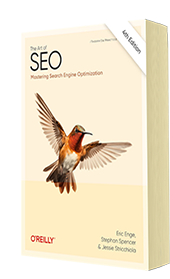
Chapter 6:
Keyword Research
From the fundamentals of link building to the nuances of natural linking patterns, virality, and authority.
Related Posts

Embrace Journaling, Tackle Tardiness, and Explore Our Energetic Echo
Here’s what I found inspirational, challenging, or just downright hilarious this week. What caught your eye? And, remember to check out this week’s great podcast episodes: Scaling a SaaS Company with Jason Morehouse “A crucial factor to business success is to find and take the personal path that works best for you.” — Jason Morehouse […]
Read More
Harrison’s harmony, conquering a blank canvas, & gut health hacks
Here’s what I found inspirational, challenging, or just downright hilarious this week. What caught your eye? And, remember to check out this week’s great podcast episodes: Be a Sales Game Changer with Fred Diamond “True elite sales professionals develop a dedicated mindset, proactive client interaction, and continuous self-preparation. They understand their client’s needs and enable […]
Read More
Rebirth of sleeper trains, 4,000 weeks is a long/short time, and golden age for medicine
Here’s what I found inspirational, challenging, or just downright hilarious this week. What caught your eye? And, remember to check out this week’s great podcast episodes: A Story Worth Retelling with Luke Storey “Aligned values are the cornerstone of successful partnerships, whether in business or life, as they shape our moral code, define our priorities, […]
Read More